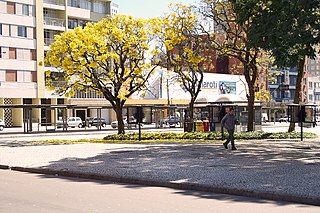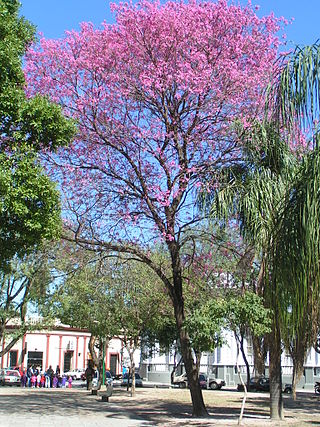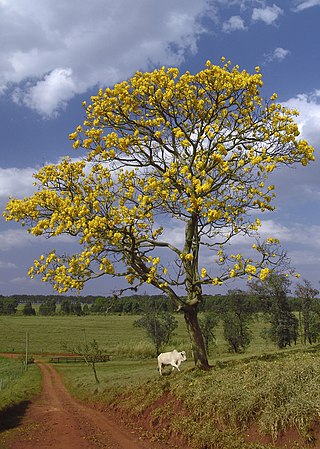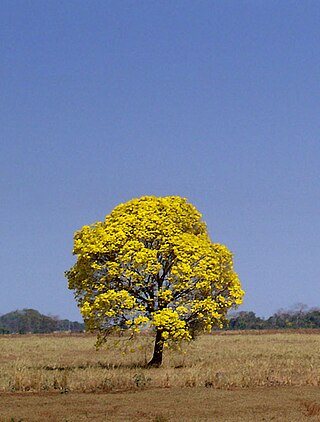
Tabebuia is a genus of flowering plants in the family Bignoniaceae. Tabebuia consists almost entirely of trees, but a few are often large shrubs. A few species produce timber, but the genus is mostly known for those that are cultivated as flowering trees.

Bignoniaceae is a family of flowering plants in the order Lamiales commonly known as the bignonias or trumpet vines. It is not known to which of the other families in the order it is most closely related.

Handroanthus albus, the golden trumpet tree, is a tree with yellow flowers native to Argentina, Paraguay, Bolivia and the Cerrado of Brazil, where it is known as ipê-amarelo-da-serra.

Handroanthus impetiginosus, the pink ipê, pink lapacho or pink trumpet tree, is a tree in the family Bignoniaceae, distributed throughout North, Central and South America, from northern Mexico south to northern Argentina. It is the national tree of Paraguay.

Tabebuia roseo-alba, known as white ipê, ipê-branco or lapacho blanco, is a tree native to Cerrado and Pantanal vegetation in Brazil, but also appears in Argentina and more rarely in Paraguay.

Tabebuia ochracea, known as corteza amarillia in Spanish, is a timber tree native to South America, Cerrado and Pantanal vegetation in Brazil. It is very similar, closely related to, and often confused with the Golden Trumpet Tree, Tabebuia chrysotricha. It is a seasonal flowering tree, blossoming only during spring (September). During this time, all leaves fall and only flowers remain in the crown.

Tabebuia aurea is a species of Tabebuia native to South America in Suriname, Brazil, eastern Bolivia, Peru, Paraguay, and northern Argentina. The common English name Caribbean trumpet tree is misleading, as it is not native to the Caribbean. It is also known as the silver trumpet tree, and tree of gold.

Handroanthus chrysotrichus, synonym Tabebuia chrysotricha, commonly known as the golden trumpet tree, is a semi-evergreen/semi-deciduous tree from Brazil. It is very similar to and often confused with Tabebuia ochracea. In Portuguese it is called ipê amarelo and its flower is considered the national flower of Brazil.

Viburnum nudum is a deciduous shrub in the genus Viburnum within the muskroot family, Adoxaceae.

Cananéia-Iguape-Peruíbe Environmental Protection Area is a protected area in the State of São Paulo, Brazil. It has been designated as a Ramsar site since 2017.

Tabebuia rosea, also called pink poui, and rosy trumpet tree is a neotropical tree that grows up to 30 m (98 ft) and can reach a diameter at breast height of up to 100 cm (3 ft). The Spanish name roble de sabana, meaning "savannah oak", is widely used in Costa Rica, probably because it often remains in heavily deforested areas and because of the resemblance of its wood to that of oak trees. It is the national tree of El Salvador, where it is called "Maquilíshuat".

Handroanthus is a genus of flowering plants in the family Bignoniaceae. It consists of 30 species of trees, known in Latin America by the common names poui, pau d'arco, or ipê. The latter sometimes appears as epay or simply ipe (unaccented) in English. The large timber species are sometimes called lapacho or guayacan, but these names are more properly applied to the species Handroanthus lapacho and Handroanthus guayacan, respectively.
Ekmanianthe is a genus of flowering plants in the family Bignoniaceae. It is most closely related to Tabebuia and has sometimes been included within it. It consists of two species of trees, neither of which is especially common in any part of its range:
Lydenburgia is a genus of plants in the family Celastraceae.

Tabebuia heterophylla is a species of tree native to the Caribbean, and is also cultivated. It is also known as Roble blanco, pink manjack, pink trumpet tree, white cedar, and whitewood.

Tabebuia elliptica is a species of Tabebuia tree native to Brazil and Bolivia.
The Chauás Ecological Station is an ecological station in the state of São Paulo, Brazil. It protects an area of lagoons and marshes in the Atlantic Forest biome, and is home to several endangered species. It is strictly protected, and is not open to the public.
The Rio da Onça State Park is a State park in the state of Paraná, Brazil.

La Robleda Natural Protected Area is a 254-acre protected natural area and conservation easement in Cayey, Puerto Rico. La Robleda, meaning 'the oak grove', gets its name from the high concentration of pink manjack trees, locally known as roble blanco, in the area. The pink manjack trees in this nature reserve bloom for a few weeks every year, creating a natural scenic spectacle of pink and white colors in the Sierra de Cayey.















